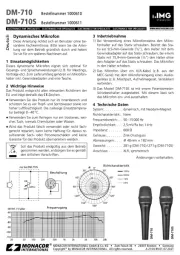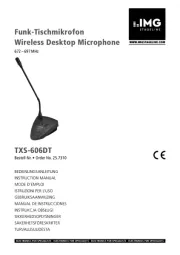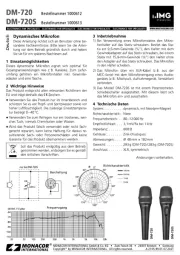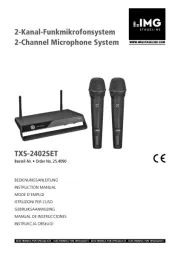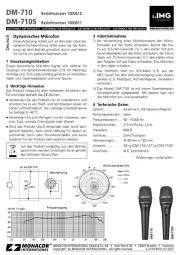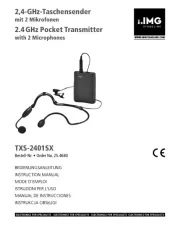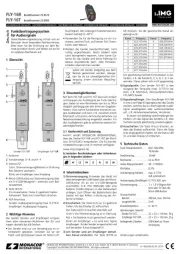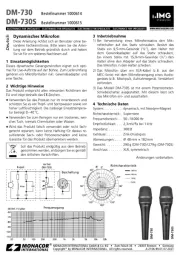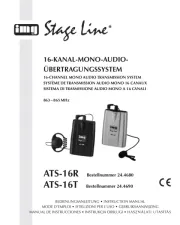
ELECTRONICS FOR SPECIALISTS ELECTRONICS FOR SPECIALISTS ELECTRONICS FOR SPECIALISTS ELECTRONICS FOR SPECIALISTS ELECTRONICS FOR SPECIALISTS ELECTRONICS
ECMS-60
Bestell-Nr. • Order No. 23.6950
MONACOR INTERNATIONAL GmbH & Co. KG • Zum Falsch 36 • 28307 Bremen • Germany
Copyright
©
by MONACOR INTERNATIONAL. All rights reserved.
A-1769.99.01.09.2017
ECMS
1
2
3
➂
➀
Frequenzgang / Frequency response
40
30
20
10
0
5020 100 200 500 1k 2k 5k 10k
30°
330°
300° 60°
90°
120°
270°
240°
210°
180°
150°
➁
Polardiagramm (bei 1 kHz) / Polar pattern (at 1 kHz)
4 Specifications
Type of microphone: � �large diaphragm condenser
microphone with FET
Pick-up pattern: � � � � � �cardioid
Frequency range: � � � � �20 – 20 000 Hz
Sensitivity: � � � � � � � � � �17�8 mV/ Pa at 1 kHz
Max� SPL: � � � � � � � � � �125 dB
S / N ratio: � � � � � � � � � �> 70 dB
Nominal impedance: � �200 Ω
Power supply: � � � � � � �phantom power 48 V
⎓
Ambient temperature: �0 – 40 °C
Dimensions: � � � � � � � �⌀ 50 mm × 130 mm
Weight: � � � � � � � � � � � �290 g
Connection: � � � � � � � � �XLR, 3 poles, balanced
Subject to technical modification.
Large Diaphragm
Condenser Microphone
These operating instructions are intended for
users with basic knowledge in audio tech-
nology. Please read the instructions carefully
prior to operating the unit and keep them for
later reference.
1 Applications
This microphone with extra thin, gold-coated
25.4 mm (1”) diaphragm is designed for profes-
sional studio and live applications and is both suit-
able for the sound pick-up of musical instruments
and for vocal sound.
For operation, the microphone requires a
phantom power of 48 V. It is supplied with a
micro phone support and a leather bag.
2 Important Notes
This microphone corresponds to all relevant direc-
tives of the EU and is therefore marked with .
•
The microphone is suitable for indoor use only.
Protect it against dripping water, splash water
and high air humidity. The admissible ambient
temperature range is 0 – 40 °C.
•
For cleaning only use a dry, soft cloth; never use
chemicals or water.
•
No guarantee claims for the microphone and
no liability for any resulting personal damage or
material damage will be accepted if the micro-
phone is used for other purposes than originally
intended, if it is not correctly connected or if it
is not repaired in an expert way.
If the microphone is to be put out of
operation definitively, take it to a local
recycling plant for a disposal which is
not harmful to the environment.
3 Setting into Operation
1) Screw the microphone holder onto a stand
with 16 mm (
5
⁄8”) thread.
2) Screw off the threaded ring (3) at the lower
part of the microphone and place the micro-
phone into the ring (1) of the holder. Turn the
micro phone so that the side with the symbol
is directed towards the sound source (figure 3).
Then retighten the threaded ring.
3) To adjust the microphone to the sound source,
release the screw (2) of the holder, position
the microphone as desired, and retighten the
screw.
4) Connect the microphone via a cable with XLR
plug (e. g. a cable of the MEC series) to a micro-
phone input of the audio unit used (e. g. mixer).
The microphone input must have a 48 V
phantom power supply. If the audio unit does
not provide any phantom power, connect the
microphone via a phantom power supply unit
(e. g. EMA-3 or EMA-200) to the audio unit.
Großmembran-
Kondensator-Mikrofon
Diese Anleitung richtet sich an Benutzer
mit Grundkenntnissen in der Audiotechnik.
Bitte lesen Sie die Anleitung vor dem Betrieb
gründlich durch und heben Sie sie für ein
späteres Nachlesen auf.
1 Einsatzmöglichkeiten
Dieses Mikrofon mit extrem dünner, goldbe-
schichteter 25,4-mm-Membran (1”) ist für profes-
sionelle Studio-und Live-Einsätze konzipiert und
eignet sich sowohl für die Schallabnahme von
Instrumenten als auch für Vokalanwendungen.
Für den Betrieb benötigt das Mikrofon eine
Phantomspeisung von 48 V. Zum Lieferumfang
gehören ein Mikrofonhalter und eine Ledertasche.
2 Wichtige Hinweise für den Gebrauch
Das Mikrofon entspricht allen relevanten Richt-
linien der EU und trägt deshalb das -Zeichen.
•
Setzen Sie das Mikrofon nur im Innenbereich
ein. Schützen Sie es vor Tropf- und Spritzwasser
sowie hoher Luftfeuchtigkeit. Der zulässige Ein-
satztemperaturbereich beträgt 0 – 40 °C.
•
Verwenden Sie zum Reinigen nur ein trockenes,
weiches Tuch, niemals Chemikalien oder Wasser.
•
Wird das Mikrofon zweckentfremdet, falsch
angeschlossen oder nicht fachgerecht repariert,
kann keine Haftung für daraus resultierende
Sach- oder Personenschäden und keine Garan-
tie für das Mikrofon übernommen werden.
Soll das Mikrofon endgültig aus dem
Betrieb genommen werden, übergeben
Sie es zur umweltgerechten Entsorgung
einem örtlichen Recycling betrieb.
3 Inbetriebnahme
1) Den Mikrofonhalter auf ein Stativ mit 16-mm-
Gewinde (
5
⁄8”) schrauben.
2) Den Gewindering (3) unten am Mikrofon ab-
schrauben und das Mikrofon auf den Aufnah-
mering (1) des Halters setzen. Das Mikrofon
so drehen, dass die Seite mit dem Symbol
in Richtung der Schallquelle zeigt (Abb. 3).
Anschließend den Gewindering wieder fest-
drehen.
3) Zum Ausrichten des Mikrofons auf die Schall-
quelle die Schraube (2) des Halters lösen, das
Mikrofon wie gewünscht ausrichten und die
Schraube wieder festziehen.
4) Das Mikrofon über ein Kabel mit XLR-Stecker
(z. B. ein Kabel der MEC-Serie) an einen Mikro-
foneingang des verwendeten Audiogeräts (z. B.
Mischpult) anschließen.
Der Mikrofoneingang muss eine 48-V-Phan-
tomspeisung aufweisen. Stellt das Audiogerät
keine Phantomspeisung bereit, das Mikrofon
über ein Phantomspeisegerät (z. B. EMA-3 oder
EMA-200) an das Audiogerät anschließen.
4 Technische Daten
Mikrofontyp: � � � � � � � �Großmembran-Konden sator-
Mikrofon mit FET
Richtcharakteristik: � � �Niere
Frequenzbereich: � � � � �20 – 20 000 Hz
Empfindlichkeit: � � � � � �17,8 mV/ Pa bei 1 kHz
Max� Schalldruck: � � � �125 dB
Signal / Rauschabstand: > 70 dB
Nennimpedanz: � � � � � �200 Ω
Stromversorgung: � � � �Phantomspeisung 48 V
⎓
Einsatztemperatur: � � � �0 – 40 °C
Abmessungen: � � � � � � �⌀ 50 mm × 130 mm
Gewicht: � � � � � � � � � � �290 g
Anschluss: � � � � � � � � � �XLR, 3-polig, symmetrisch
Änderungen vorbehalten.
DeutschEnglish

